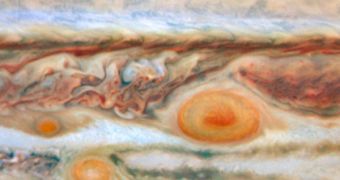What was until now a party of one appears to be turning into a rather crowded gathering of red spots in the Jovian atmosphere. The Great Red Spot and its little sister, the Little Red Spot anticyclone, were joined relatively recently by yet another storm that turned from bright white to red, in what astronomers like to call a case of planetary measles. Observations were made with the Hubble Space Telescope and the Keck telescope between May 9 and May 11 this year.
The Great Red Spot - raging across Jupiter's atmosphere for the last 200 to 350 years - was joined in the spring of 2006 by an anticyclone that suddenly turned red. Since then the storm was called the Little Red Spot, being considerably smaller than the Great Red Spot. Until a couple of days ago, the Little Red Spot was the youngest and one of the fastest storms in the solar system, reaching wind speeds of over 614.4 kilometers per hour.
Observations show that since the Little Red Spot appeared in Jupiter's atmosphere its larger sister has been steadily decreasing in size, allowing it to grow. However, what causes these powerful storms and why they have turned red remains a mystery. Some astronomers have proposed that their color might be caused by material being scooped up from deep inside Jupiter and raised into the upper layer of the atmosphere, where it is exposed to ultraviolet radiation coming from the Sun, thus changing color to the distinctive red we see now.
The newly formed storm could meet up with the Great Red Spot in August, when they will probably merge or the Great Red Spot will simply shove its smaller sister to one side and be on its way.
Visible-light and near-infrared analysis of the three storms show that they appear relatively bright in near-infrared light, meaning that they are towering above the planet's methane atmosphere, since methane absorbs infrared light and appears black in infrared images. Jupiter's atmosphere entered a turbulent state some two years ago, according to images taken by the two telescopes, while almost a year ago the band surrounding the Great Red Spot - usually relatively calm - turned extremely turbulent towards both sides of the storm.
In 2004, Phil Marcus from the University of California proposed that Jupiter was going through a global climate change and would suffer temperature variations between 15 and 20 degrees Fahrenheit, thus while the planet would get warmer near the equatorial regions, the south pole would cool considerably. He also predicted that significant changes would start to appear in 2006, when jet streams inside the atmosphere would become unstable and would spawn new storms.

 14 DAY TRIAL //
14 DAY TRIAL //